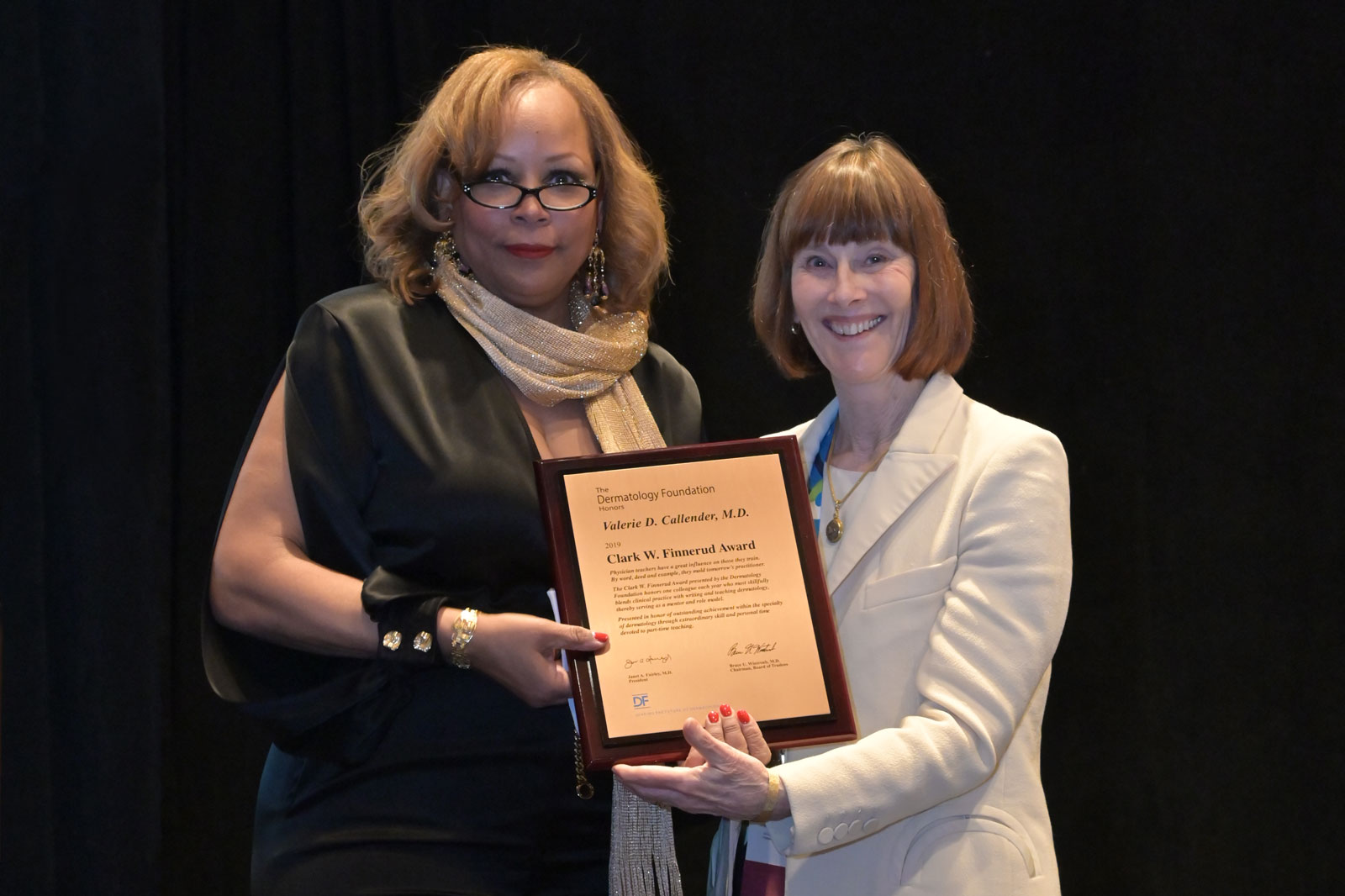
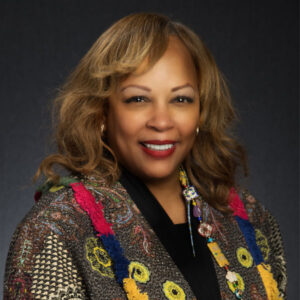
Dr. Valerie D. Callender has led a busy full-time practice, Callender Dermatology & Cosmetic Center, for 33 years in the suburbs of Washington, DC.
Dr. Valerie D. Callender has led a busy full-time practice, Callender Dermatology & Cosmetic Center, for 33 years in the suburbs of Washington, DC. She also has a clinical research center directing studies on alopecia, acne, psoriasis, atopic dermatitis, vitiligo, and cosmetic devices. Her expertise is in treating pigmentation disorders and hair loss in women.
While she is focused on her private practice, Monday through Friday, two Saturday mornings every month, she also dedicates her time to teaching and mentoring Howard dermatology residents and medical students, where she is on the voluntary faculty and Professor of Dermatology at the College of Medicine. In addition, on weekends, she attends national and international conferences, gives presentations, and writes papers or chapters for textbooks.
Dr. Callender is devoted to teaching, lecturing, and researching dermatologic conditions primarily affecting diverse patient populations.
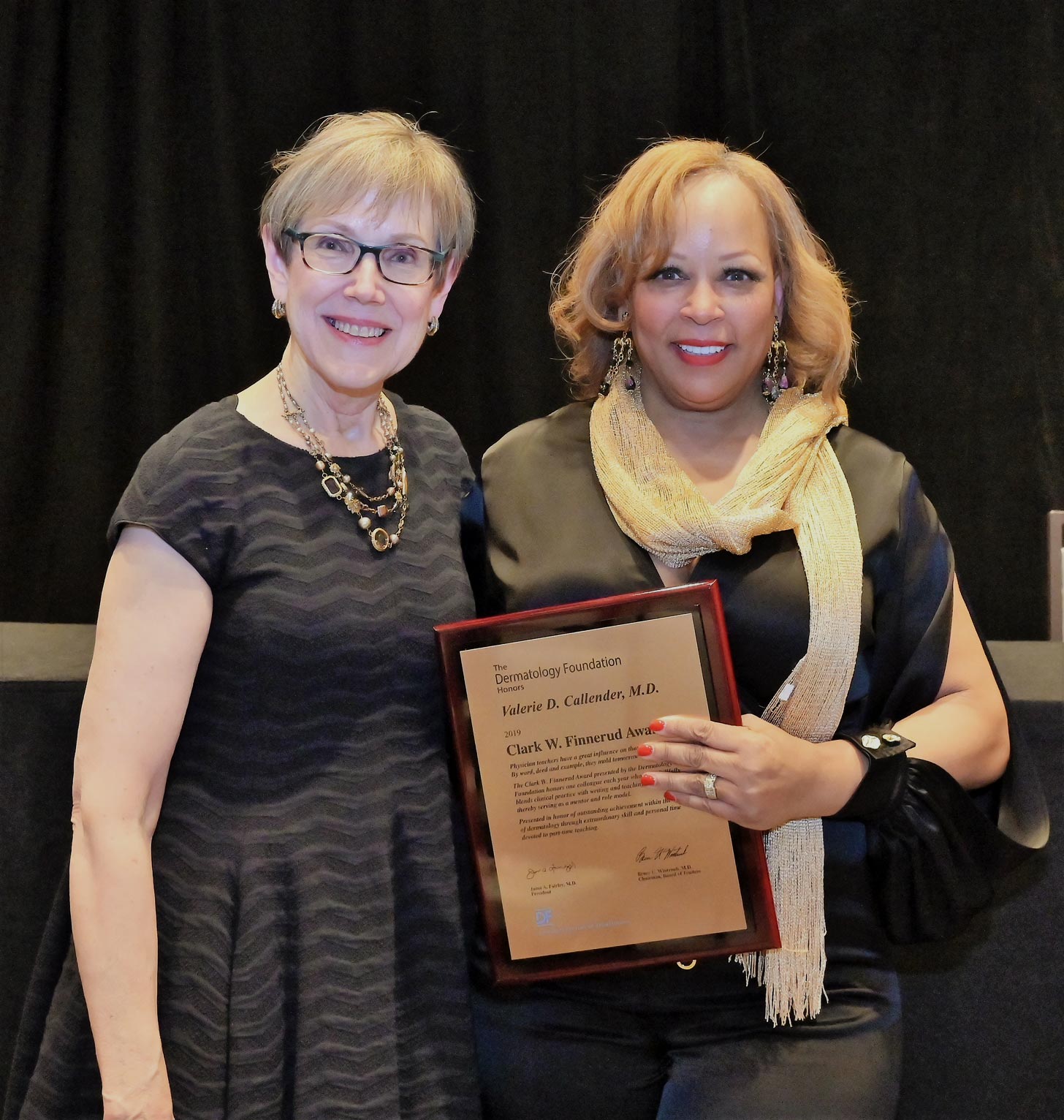
Dr. Elise Olsen (left) and Clark W. Finnerud award recipient Dr. Callender.
Peer recognition
In March 2022, Dr. Callender received the Dermatology Foundation’s Clark W. Finnerud Award, established in 1971 and presented to an individual who “most skillfully blends clinical practice with writing and teaching dermatology, thereby serving as a mentor and role model.”
Later that year in October, she was elected president of the American Dermatological Association (ADA) — she is the seventh woman, the third African American, and the first African American woman to become president of the ADA.
Why choose?
Dr. Callender concedes that balancing academia and clinical practice is an art and that not everyone may have the requisite attributes. “You need to apply the qualities of a leader – being organized, dedicated, able to multi-task, and laser-focused on what you are doing at any given time.”
While many of her students and residents believe they must choose between being a full-time academician, who publishes, does research, and teaches; or a private practitioner managing a business, she maintains they don’t have to choose one or the other.
The same goal
A good clinician cares for patients and keeps abreast of current research and treatments. Likewise, a good professor takes care of students — who eventually will have patients of their own — and stays abreast of new developments. However, their focus is on research and publication. “Ultimately, both paths have the same goal: delivering excellent patient care,” she said. “It’s a shared goal — dermatology excellence.”
In black and white
Dr. Callender began her teaching career as a clinical instructor while in full-time practice. Today, she is a professor at Howard University; teaches skin-of-color dermatology to colleagues around the world; and residents and medical students at many US training programs.
More than thirty years ago medical schools trained neither Dr. Callender nor her peers to recognize identical disorders on white and skin-of-color patients. Textbooks and academic articles featured mainly Caucasian patients. However, during her residency in the clinic at Howard, she says “we were trained on the clinical manifestations of skin conditions in both black and white patients.”
Inclusive research
The situation is improving. Pharmaceutical and cosmetic companies researching skin conditions are now selecting dermatologists of color as principal investigators to reach out to study participants of color to be included in clinical studies. In addition, organizations like the Skin of Color Society (SOCS), Women’s Dermatologic Society (WDS), American Society of Dermatologic Surgery (ASDS), and the American Academy of Dermatology (AAD) have developed programs to address the need for diversity in clinical trials and across the specialty.
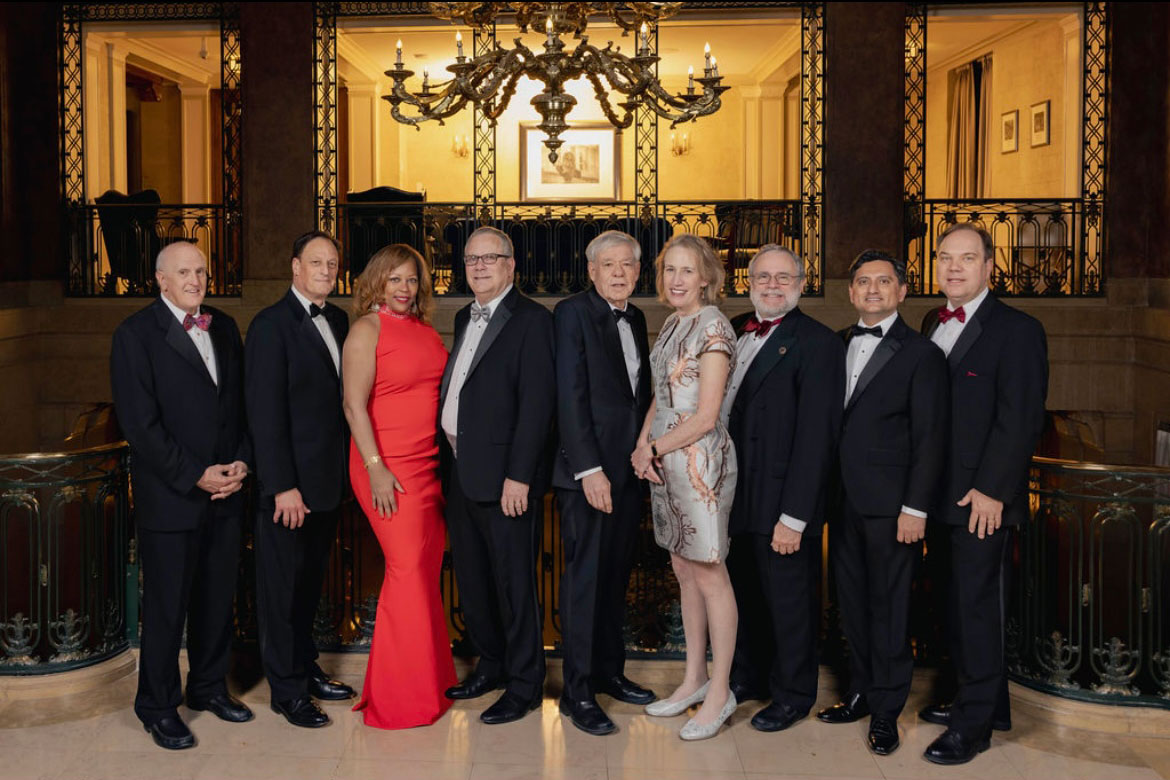
Dr. Callender (in red) with the 2022-2023 ADA Board of Directors in October 2022. She is the first African American woman to become president of the ADA.
Transfer of knowledge
Her philosophy as a mentor is to inspire the next generation of dermatologists by transferring knowledge unavailable to her and her colleagues when they were in medical school.
As a mentor and role model, Dr. Callender’s participation in numerous dermatology organizations has led her to increase diversity among students, professors, and publications. For example, the WDS, of which she is a past president, has mentorship programs to support women who want to rise to leadership positions. The organization has also made significant strides to increase racial diversity in dermatology.
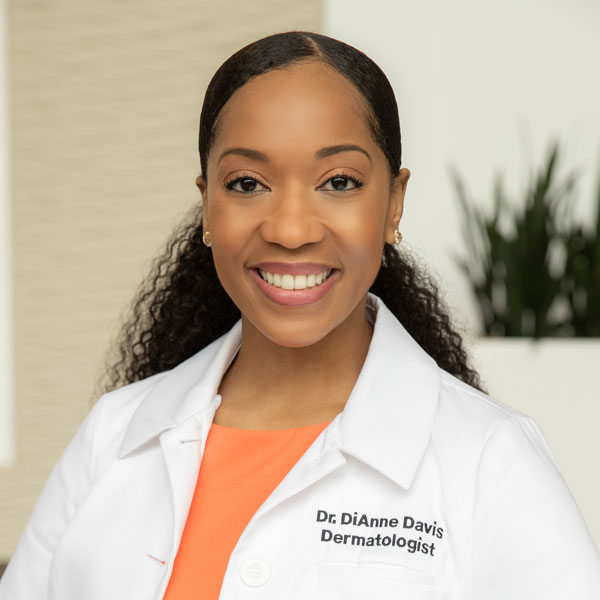
DiAnne Davis, MD, dermatologist and former student
“As an African American dermatologist, I cannot say enough about the mentorship I received from Dr. Valerie Callender. During my second year of medical school, she took me under her wing as a mentee in the AAD diversity mentorship program. She taught me so much about the field of dermatology, including surgical procedures, cosmetic procedures, and how to really make a difference in my patients’ lives. She has helped me publish research projects, get involved in multiple organizations, and navigate my career post residency. She is someone that I admire and honor, not only during Black History Month, but every month. I want to celebrate my mentor, Dr. Valerie Callender, and everything she has contributed to the field of dermatology.”
A devoted DF member
Dr. Callender has been a member of the Dermatology Foundation for close to 30 years and a Leaders Society Campaign Vice Chair for five years. As an Annenberg Circle Sustainer, she is deeply committed to supporting emerging investigators.
“The DF supports individuals doing research, the majority of whom pursue basic science research. I support it because I believe it’s important for us to contribute to the advancement of our specialty.”
Past Foundation executive committee leaders, Dr. Jim Leyden (past chair), Dr. Michael Tharp (former president), and Dr. Bruce Wintroub (former president and chair), motivated her to become a member and volunteer. “They supported and encouraged me to speak and be heard,” she says.
The power of mentorship
Her first role model was Dr. Pearl Grimes, a faculty member at Howard when Dr. Callender was a medical student. Listening to Dr. Grimes deliver a lecture on clinical diagnosis and internal disease was life-changing. “It fascinated me that skin can tell you so much about the human body.” That is when she decided to become a dermatologist.
She approached Dr. Grimes for advice on how to proceed. “She suggested I do research because entry to dermatology was competitive and difficult.”
Before Dr. Grimes left Howard to work in a medical center in California, she introduced Dr. Callender to someone who became her mentor for life: Dr. John A. Kenney Jr., known as the father of black dermatology, and Chairman of the Howard University Department of Dermatology. He received the AAD Master Dermatologist Award in 1995 and the AAD Gold Medal Award in 2001. He also received the Clark W. Finnerud Award in 1988.
Another key mentor, Dr. Rebat Halder, was the director of the vitiligo center where, under his tutelage, she researched the natural history of vitiligo.
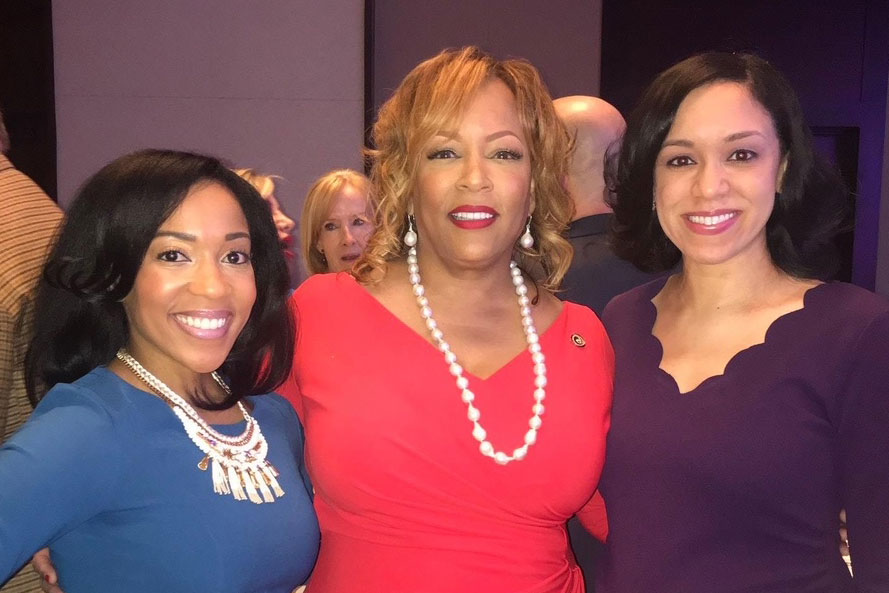
Dr. DiAnne Davis (left) and Dr Christina Lawson Daniels (right) with their mentor and role model Dr. Callender (center).
Career-defining research
The research earned her accolades, but interviewing the patients who participated in the study was the most rewarding and career-defining. “Some felt stigmatized because of the contrast between their healthy skin and the areas of depigmentation, she says.
“It affected their quality of life, and more importantly, their self-esteem.”
Dr. Callender resolved to help them.
She entered the dermatology program at Howard, focusing on pigmentation disorders, and pursued her work with Dr. Halder.
“A mentor is someone who really goes out of their way, beyond the call of duty, to include you, lift you, and support you,” said Dr. Callender.
Her students would agree.
Learn more about the DF Honorary Awards.
BIOGRAPHY
Dr. Valerie D. Callender is a Board-Certified Dermatologist known for her sensitive and cutting-edge approach to managing hair loss in women and treating pigmentation disorders. She is past president of the Women’s Dermatologic Society, the Skin of Color Society, and the Dermatology Section of the National Medical Association. In 2022, she was elected president of the American Dermatological Association. She has also served on the American Academy of Dermatology Board of Directors and Executive Committee.
She is the Founder and Medical Director of the Callender Dermatology & Cosmetic Center in the Washington, DC, metropolitan region. Dr. Callender received her medical degree from Howard University, where she also did her residency and currently serves as a Professor of Dermatology at the College of Medicine. She is the recipient of the Women’s Dermatologic Society President’s Award and Mentor of the Year Award. She received the Dermatology Foundation’s Clark W. Finnerud Award in 2022, bestowed each year to someone who has devoted extraordinary time and talent as a clinician and part-time professor.
She has conducted and participated in 53 research studies and clinical trials for therapeutic and cosmetic products, published 86 articles in academic journals, written 22 textbook chapters, and co-edited a Treatment for Skin of Color textbook. Dr. Callender is a frequent speaker at the AAD summer and winter sessions, and since 2000 has delivered 348 presentations to dermatology societies worldwide.
PUBLICATIONS
Ohanenye C, Taliaferro, S, Callender VD. Diagnosing Disorders of Facial Erythema. Dermatol Clin. 2023.02.004. www.sciencedirect.com/science/article/abs/pii/S0733863523000141?via%3Dihub
Fabi S, Callender VD, Lee W, Dayan S. Aesthetic Considerations for Treating the North American Multi-Ethnic Patient: Thriving in Diversity International Roundtable Series. J Cosmet Dermatol. 2022:29 (9)1-9 15422. https://pubmed.ncbi.nlm.nih.gov/36176035/
Kaufman J, Callender VD, Young C, Jones P, Wortzman M, Nelson D. Efficacy and Tolerability of a Retinoid Eye Cream for fine to Moderate Wrinkles of the Periorbital Region. J Drugs Dermatol. 2022:21 (9)932-937. https://jddonline.com/articles/efficacy-and-tolerability-of-a-retinoid-eye-cream-for-fine-to-moderate-wrinkles-of-the-periorbital-region-S1545961622P0932X/

